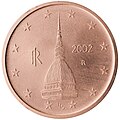Italian euro design
For images of the common side and a detailed description of the coins, see euro coins.
| €0.01 | €0.02 | €0.05 |
|---|---|---|
 |  |  |
| Castel del Monte, a 13th-century castle in Andria | Mole Antonelliana, a tower symbolising the city of Turin | Colosseum, famous Roman amphitheater |
| €0.10 | €0.20 | €0.50 |
 |  |  |
| The Birth of Venus by Sandro Botticelli | Futurist sculpture Unique Forms of Continuity in Space by Umberto Boccioni | Equestrian Statue of Marcus Aurelius |
| €1.00 | €2.00 | €2 Coin Edge |
 |  | |
| Vitruvian Man , a drawing by Leonardo da Vinci | Dante Alighieri, an Italian poet, writer and philosopher, considered the father of the Italian language |


